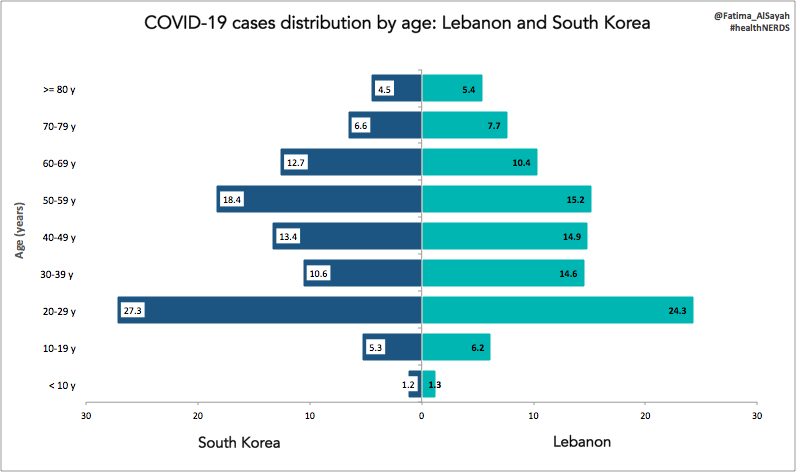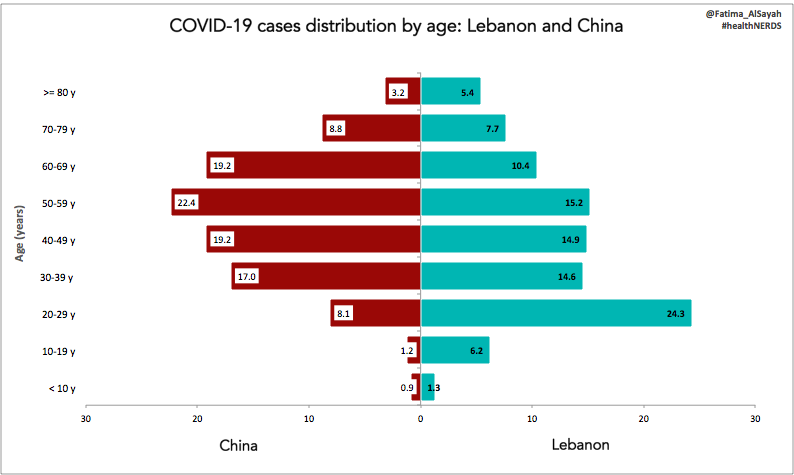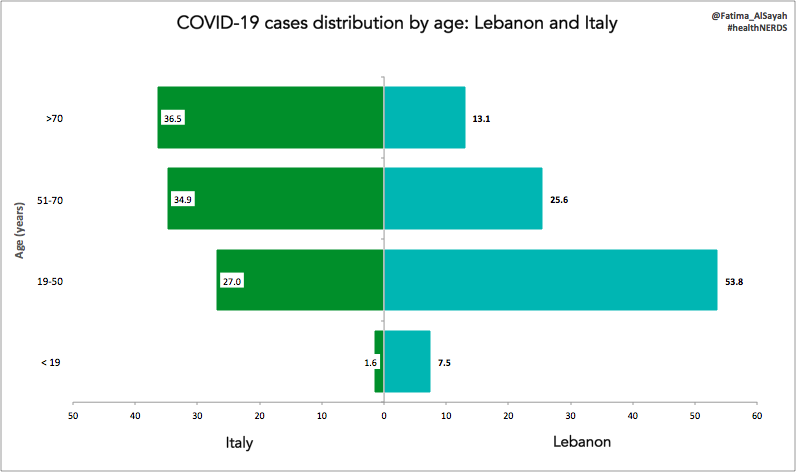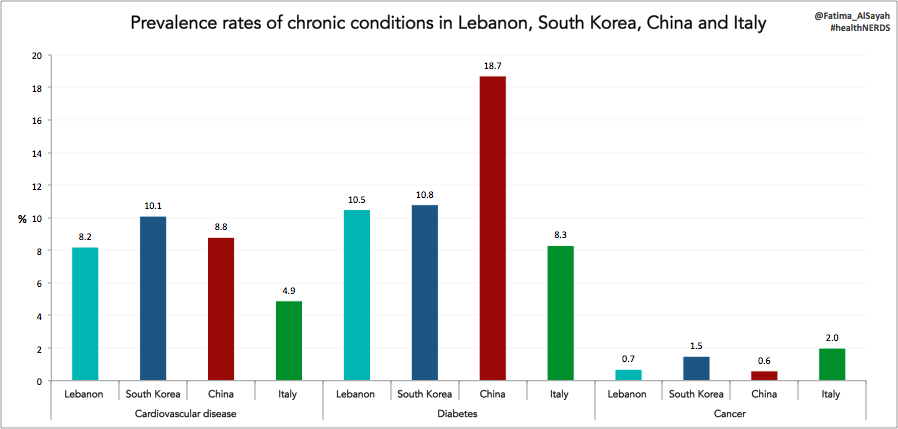COVID-19 in Lebanon https://abs.twimg.com/emoji/v2/... draggable="false" alt="🇱🇧" title="Flag of Lebanon" aria-label="Emoji: Flag of Lebanon">: What does the age distribution of confirmed cases tell us about under-reporting of cases?
https://abs.twimg.com/emoji/v2/... draggable="false" alt="🇱🇧" title="Flag of Lebanon" aria-label="Emoji: Flag of Lebanon">: What does the age distribution of confirmed cases tell us about under-reporting of cases?
A comparison with South Korea https://abs.twimg.com/emoji/v2/... draggable="false" alt="🇰🇷" title="Flag of South Korea" aria-label="Emoji: Flag of South Korea"> China
https://abs.twimg.com/emoji/v2/... draggable="false" alt="🇰🇷" title="Flag of South Korea" aria-label="Emoji: Flag of South Korea"> China  https://abs.twimg.com/emoji/v2/... draggable="false" alt="🇨🇳" title="Flag of China" aria-label="Emoji: Flag of China"> & Italy
https://abs.twimg.com/emoji/v2/... draggable="false" alt="🇨🇳" title="Flag of China" aria-label="Emoji: Flag of China"> & Italy  https://abs.twimg.com/emoji/v2/... draggable="false" alt="🇮🇹" title="Flag of Italy" aria-label="Emoji: Flag of Italy">
https://abs.twimg.com/emoji/v2/... draggable="false" alt="🇮🇹" title="Flag of Italy" aria-label="Emoji: Flag of Italy">
@mophleb @DRM_Lebanon @WHOLebanon @thehealthnerds
#Lebanon #COVID19 #healthNERDS
A comparison with South Korea
@mophleb @DRM_Lebanon @WHOLebanon @thehealthnerds
#Lebanon #COVID19 #healthNERDS
1/ Age is an important factor not only because older people may have diminished immune function, but also because chronic conditions like cardiovascular disease & diabetes (key risk factors for worse outcomes in COVID-19) are much more prevalent in those over 50 years old.
2/ As of April 11:
Lebanon had a total of 630 cases |20 deaths (CFR= 3.2%)
South Korea had a total of 10,480 cases | 211 deaths (CFR= 2.0%)
China had a total of 82,800 cases | 3,339 deaths (CFR= 2.3%)
Italy had a total of 152,300 cases | 19,500 deaths (CFR= 12.5%)
Lebanon had a total of 630 cases |20 deaths (CFR= 3.2%)
South Korea had a total of 10,480 cases | 211 deaths (CFR= 2.0%)
China had a total of 82,800 cases | 3,339 deaths (CFR= 2.3%)
Italy had a total of 152,300 cases | 19,500 deaths (CFR= 12.5%)
3/ CFR (# of deaths/# of total cases) depends on:
-Age of infected individuals
-Health condition of infected individuals
-Availability & access to needed healthcare
CFR is not constant; the only stable CFR can be calculated when the outbreaks ends.
-Age of infected individuals
-Health condition of infected individuals
-Availability & access to needed healthcare
CFR is not constant; the only stable CFR can be calculated when the outbreaks ends.
4/ The age distribution of infected individuals in a country depends on the age distribution of the overall population & the transmission patterns (e.g., older people are more susceptible than others).
Let’s examine age distribution in Lebanon vs. South Korea, China, and Italy.
Let’s examine age distribution in Lebanon vs. South Korea, China, and Italy.
5/ Lebanon has a “younger” population compared to South Korea, China, and Italy (with larger differences compared to China & Italy)
6/ So, does this population age distribution affect the age distribution of COVID-19 cases?
The short answer is yes.
The short answer is yes.
10/ Given the above, it’s reasonable to assume that the CFR in Lebanon should be lower than these countries. We can check that using the “Vulnerability Factor” (VF), which tells us whether the risk of death should be higher or lower based on population demographics.
11/ VF is calculated as follows  https://abs.twimg.com/emoji/v2/... draggable="false" alt="👇" title="Down pointing backhand index" aria-label="Emoji: Down pointing backhand index">whereby
https://abs.twimg.com/emoji/v2/... draggable="false" alt="👇" title="Down pointing backhand index" aria-label="Emoji: Down pointing backhand index">whereby
"T" is the target country (Lebanon)
"B" is the benchmark country (South Korea, China, Italy)
"fBi" is the fraction of the population with the age i for benchmark country
"ri" is the CFR for age i
"T" is the target country (Lebanon)
"B" is the benchmark country (South Korea, China, Italy)
"fBi" is the fraction of the population with the age i for benchmark country
"ri" is the CFR for age i
12/ If VF(T|B) > 1, then the population of T has a higher risk of death due to larger % of older population; it results in higher CFR compared to B.
If VF(T|B) < 1, then T (Lebanon) has a younger population and it should result in a lower CFR compared to B.
If VF(T|B) < 1, then T (Lebanon) has a younger population and it should result in a lower CFR compared to B.
13/ So what is the VF for Lebanon compared to South Korea, China & Italy?
VF (Leb|South Korea) = 0.52
VF (Leb|China) = 0.70
VF (Leb|Italy) = 0.37
In all cases the VF is < 1, so the CFR in Lebanon (based on our younger population) should be lower than these countries.
VF (Leb|South Korea) = 0.52
VF (Leb|China) = 0.70
VF (Leb|Italy) = 0.37
In all cases the VF is < 1, so the CFR in Lebanon (based on our younger population) should be lower than these countries.
14/Current CFR in Lebanon (3.2%) is < Italy (12.5%) but > South Korea (2.0%) & China (2.3%). Why?
- Lebanon has more people with chronic conditions
- Under-reporting of total cases due to limited testing
Let’s check out the prevalence of chronic conditions in these countries
- Lebanon has more people with chronic conditions
- Under-reporting of total cases due to limited testing
Let’s check out the prevalence of chronic conditions in these countries
15/ Overall, Lebanon is not worse than these countries in terms of prevalence of chronic conditions.
16/ CFR= (# of deaths/# of cases)
If # of cases is under-reported (i.e., smaller), the CFR will be higher.
Of course other factors such as access to care, quality of care, timeliness of seeking care matter. Currently, these factors do not seem to be an issue in Lebanon.
If # of cases is under-reported (i.e., smaller), the CFR will be higher.
Of course other factors such as access to care, quality of care, timeliness of seeking care matter. Currently, these factors do not seem to be an issue in Lebanon.
17/ Conclusion  https://abs.twimg.com/emoji/v2/... draggable="false" alt="➡️" title="Rightwards arrow" aria-label="Emoji: Rightwards arrow"> WE NEED TO TEST MORE, A LOT MORE.
https://abs.twimg.com/emoji/v2/... draggable="false" alt="➡️" title="Rightwards arrow" aria-label="Emoji: Rightwards arrow"> WE NEED TO TEST MORE, A LOT MORE.
18/ Data sources and references:
https://www.medrxiv.org/content/10.1101/2020.03.14.20036178v2
https://www.medrxiv.org/content/1... href=" https://www.populationpyramid.net/lebanon/2020/ ">https://www.populationpyramid.net/lebanon/2...
https://www.kaggle.com/lachmann12/world-population-demographics-by-age-2019
https://www.kaggle.com/lachmann1... href=" https://gco.iarc.fr/
https://gco.iarc.fr/">... href=" https://bmcpublichealth.biomedcentral.com/articles/10.1186/s12889-019-7439-0
https://bmcpublichealth.biomedcentral.com/articles/... href=" https://www.e-epih.org/journal/view.php?number=1044
https://www.e-epih.org/journal/v... href=" https://www.idf.org/our-network/regions-members/europe/members/142-italy.html">https://www.idf.org/our-netwo... https://jamanetwork.com/journals/jamacardiology/fullarticle/2727339">https://jamanetwork.com/journals/...
https://www.medrxiv.org/content/10.1101/2020.03.14.20036178v2
https://www.kaggle.com/lachmann12/world-population-demographics-by-age-2019
@threadreaderapp unroll please
@DimassiZakia @Sgf98 @planetperfume @kboudargham @IyadAlMohtar @malackabbas @RH4N6 @HishamBahmad @assafnicole @Rami_J_Nasr @hadito13 @KnowYourMeal @KBadd @adib_elio @JaroudiH @DrMarwanBahmad @tania_abinassif @MiaAtoui
@Rattibha unroll please

 Read on Twitter
Read on Twitter



 whereby "T" is the target country (Lebanon)"B" is the benchmark country (South Korea, China, Italy)"fBi" is the fraction of the population with the age i for benchmark country "ri" is the CFR for age i" title="11/ VF is calculated as follows https://abs.twimg.com/emoji/v2/... draggable="false" alt="👇" title="Down pointing backhand index" aria-label="Emoji: Down pointing backhand index">whereby "T" is the target country (Lebanon)"B" is the benchmark country (South Korea, China, Italy)"fBi" is the fraction of the population with the age i for benchmark country "ri" is the CFR for age i" class="img-responsive" style="max-width:100%;"/>
whereby "T" is the target country (Lebanon)"B" is the benchmark country (South Korea, China, Italy)"fBi" is the fraction of the population with the age i for benchmark country "ri" is the CFR for age i" title="11/ VF is calculated as follows https://abs.twimg.com/emoji/v2/... draggable="false" alt="👇" title="Down pointing backhand index" aria-label="Emoji: Down pointing backhand index">whereby "T" is the target country (Lebanon)"B" is the benchmark country (South Korea, China, Italy)"fBi" is the fraction of the population with the age i for benchmark country "ri" is the CFR for age i" class="img-responsive" style="max-width:100%;"/>



